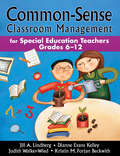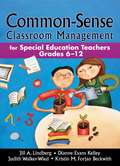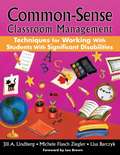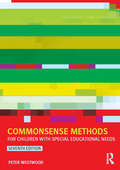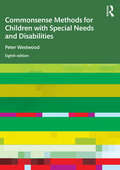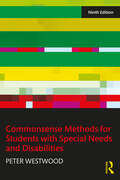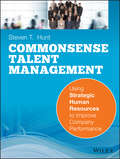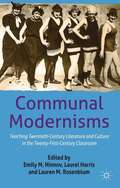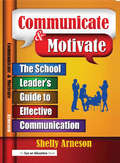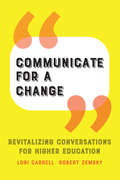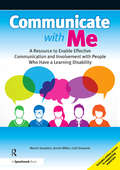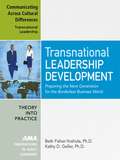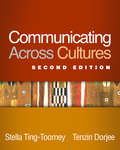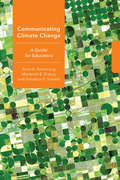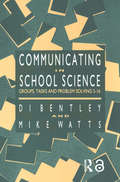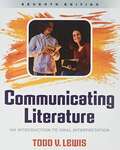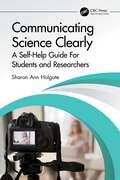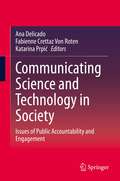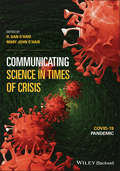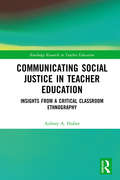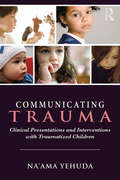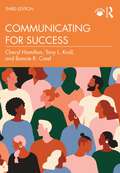- Table View
- List View
Common-Sense Classroom Management for Special Education Teachers, Grades 6-12
by Jill A. Lindberg Dianne Evans Kelley Judith K. Walker-Wied Kristin M. BeckwithThese 80 easy to adapt strategies work in five steps or fewer to help special educators feel confident about working with co-teachers, teacher aides, support staff, administrators, and families.
Common-Sense Classroom Management: For Special Education Teachers, Grades 6-12 (1-off Ser.)
by Jill A. Lindberg Kristin M. Forjan Beckwith Judith Walker-Wied Dianne Evans KelleyIf you're a teacher new to special education, this book is for you! This newest Common-Sense Classroom Management guide addresses the most critical challenges that arise when teaching adolescent learners with special needs. In this flexible and easy-to-implement resource, educators will find 80 concise and teacher-tested strategies. Each strategy works in five steps or fewer, helping special educators feel competent and confident about working with co-teachers, teacher aides, support staff, administrators, and families. The authors, all special education experts, provide practical assistance with: * Specially designed instruction and student organization to make teaching more effective * Legal responsibilities aligned with IDEIA and NCLB requirements * Positive behavioral supports, including incentive programs and meaningful consequences Ideal for teachers new to special education, teacher trainers, and teacher mentors, this resource provides a clear-sighted focus to help you shape the structure of each teaching day and ensure success for all your learners with special needs!
Common-Sense Classroom Management: Techniques for Working with Students with Significant Disabilities
by Jill A. Lindberg Lisa Barczyk Michele Flasch ZieglerToday's diverse classrooms challenge even the most experienced teachers. Using an easy-to-read format, this resource offers tools and techniques that teachers can use to reach all learners, particularly those with more significant disabilities, and give them the support they need to succeed.
Common-Sense Evidence: The Education Leader's Guide to Using Data and Research (Educational Innovations Series)
by Nora Gordon Carrie ConawayWritten by two leading experts in education research and policy, Common-Sense Evidence is a concise, accessible guide that helps education leaders find and interpret data and research, and then put that knowledge into action. In the book, Nora Gordon and Carrie Conaway empower educators to address the federal Every Student Succeeds Act mandate that schools use evidence-based improvement strategies. Recommendations include utilizing existing research; generating evidence on the success of their own improvement efforts; and building an organizational culture of evidence use. The authors walk readers through the processes for determining whether research is relevant and convincing; explain useful statistical concepts; and show how to quickly search for and scan research studies for the necessary information. The book directs readers through case studies of typical scenarios including a superintendent trying to reduce chronic absenteeism; a middle school math department chair trying to improve student performance on exams; and a chief state school officer attempting to recruit teachers for rural schools.Common-Sense Evidence helps education leaders build capacity for evidence-based practice in their schools and districts.
Commonsense Methods for Children with Special Educational Needs
by Peter WestwoodThis fully revised and updated seventh edition of Commonsense Methods for Children with Special Educational Needs continues to offer practical advice on evidence-based teaching methods and intervention strategies for helping children with a wide range of disabilities or difficulties. The advice the author provides is embedded within a clear theoretical context and draws on the latest international research and literature from the field. Coverage includes: learning difficulties and disabilities students with autism spectrum disorders, intellectual disability, physical or health issues, and sensory impairments gifted and talented students developing social skills and self-management behaviour management teaching methods literacy and numeracy curriculum differentiation and adaptive teaching computer-based instruction and e-learning. Peter Westwood also provides additional information and advice on transition from school to employment for students with disabilities, lesson study, e-learning, and computer-aided instruction, and reflects on the important changes made within the latest Diagnostic and Statistical Manual of Mental Disorders (DSM-5).
Commonsense Methods for Children with Special Needs and Disabilities
by Peter WestwoodThis fully revised and updated eighth edition of Peter Westwood’s book offers practical advice and strategies for meeting the challenge of inclusive teaching. Based on the latest international research from the field, it offers practical advice on both new and well-tried evidence-based approaches and strategies for teaching students with a wide range of difficulties. As well as covering special educational needs, learning difficulties, and disabilities in detail, chapters also explore topics such as self-management and autonomy, managing behaviour, and social skills. The book offers sound pedagogical practices and strategies for adapting curriculum content, designing teaching materials, differentiating instruction for mixed-ability classes, and implementing inclusive assessment of learning. Key features of this new edition include: Additional information on linking all aspects of teaching to a Response-to-Intervention Model A focus on the increasing importance of digital technology in supporting the learning of students with special educational needs and disabilities Up-to-date resource lists for each chapter, for those who wish to pursue a particular topic in greater depth Reflecting cutting-edge international research and teaching practices, this is an invaluable resource for practising and trainee teachers, teaching assistants, and other educational professionals looking to support students with special educational needs and disabilities.
Commonsense Methods for Students with Special Needs and Disabilities
by Peter WestwoodThis fully revised ninth edition continues to offer teachers practical advice on new evidence-based approaches for teaching and managing students with a wide range of abilities, disabilities, and difficulties.Based on topical international research from the field, this new edition provides practical advice for teachers and tutors to enable them to adapt evidence-based methods when working in inclusive settings with students with special needs, including gifted and talented students. Throughout the text, approaches to teaching and classroom management have been clearly described. New methods, programmes, and interventions are reviewed, and there is increased coverage of digital technology and e-learning. Teachers will also find support and guidance for working with students with learning difficulties in literacy and numeracy, teaching students with physical, sensory and intellectual disability, fostering students’ autonomy, social skills interventions, approaches to autism spectrum disorders, and much more. All new information in every chapter is fully supported with reference to the most recent writing and research.This continues to be an invaluable resource for practising and trainee teachers, tutors, teaching assistants, and other education professionals responsible for supporting students in inclusive schools.
Commonsense Talent Management
by Steven T. HuntA comprehensive guide to using strategic HR methods to increase company performance. This book explains what strategic human resources means, how it differs from other HR activities, and why it is critical to business performance. It walks through key questions for designing, deploying and integrating different strategic HR processes including staffing, performance management, compensation, succession management, and development The book also addresses the role of technology in strategic HR, and discusses how to get companies to support, adopt, and maintain effective strategic HR processes The book includes dozens of illustrative examples of effective and ineffective strategic HR using stories drawn from a range of companies and industries.
Communal Modernisms
by Emily M. Hinnov Laurel Harris Lauren M. RosenblumDrawing from recent research that seeks to expand our understanding of modernism, this volume offers practical pedagogical approaches for teaching modernist literature and culture in the twenty-first century classroom.
Communicate & Motivate: The School Leader's Guide to Effective Communication
by Shelly ArnesonDevelop the skills you need to communicate effectively and in ways that motivate your faculty towards success. Written especially for principals and other administrators, this book will empower you to communicate well as you work to promote a student-centered environment best suited to schoolwide achievement.
Communicate for a Change: Revitalizing Conversations for Higher Education
by Robert Zemsky Lori CarrellThis is a different kind of book: a call for courageous conversations focusing on nine taboo subjects that bedevil higher education.For nearly a decade, distinguished scholars Lori Carrell and Robert Zemsky have been having frank conversations with each other—and with colleagues and friends—about the state of higher education. In Communicate for a Change, they bring together nine of their most insightful conversations to explore difficult questions that today's administrators, trustees, and faculty members too frequently avoid. Why, Carrell and Zemsky ask, is it so hard to talk about the mess that higher education is in? And how can we refocus the conversation on what really matters, grappling with taboo subjects in a way that helps to revitalize higher education from the inside out? Grounded in the real, as opposed to the rhetorical, importance of community in making change, these revealing conversations also explore• why the public no longer sees faculty as heroes and experts• how to overcome the academy's fondness for slogans• how money talks• why curricular change doesn't (usually) happen• the students we hardly know and how we might come to know them better• how to constructively approach differences of race and gender• and much moreA golden thread weaves its way through the book, revealing the premise that rich, honest talk can generate trust, connection, and fresh ideas for revolutionary change. Carrell, the chancellor of the University of Minnesota Rochester, is by both training and instinct a testifier. Learning for her is tangible, a product of truly getting dirty, sorting through the muck of conflict as well as connection. Zemsky, on the other hand, is a provocateur who pushes an argument as a means to explore differences and conflicts. Both are natural storytellers. Their conversations are enriched by the contributions of a host of higher education experts and leaders. Breaking new ground in terms of both its subject matter and its format, Communicate for a Change is an accessible and engaging catalyst that will kick-start subsequent deliberations.
Communicate with Me
by Catherine Edwards Martin Goodwin Jennie MillerHow can I communicate even more effectively with people who have learning disabilities? Communicate with Me is an invaluable toolkit for carers, professionals, schools and services striving to improve the quality of their communication with those they support. Key features include: a comprehensive range of techniques and guidance for carers and professionals around how to communicate with and involve children and adults with learning disabilities; a wealth of practical examples and case studies to illustrate and contextualise the suggested approaches; a detailed quality assurance framework to help schools and services develop CPD, establish excellence across their organisations in the way that they communicate with people with learning difficulties and improve outcomes for those they support. Communicate with Me is a resource for anyone involved in supporting children or adults with a learning disability including residential or community support workers, play workers, advocates and teachers who work directly with people, as well as line managers and service managers who can facilitate change within service structures and promote good practice in their teams. Martin Goodwin is an experienced practitioner who has more than 18 years experience in working with children and young people in a range of capacities including management and direct delivery. Martin is a qualified teacher/ trainer in post compulsory education and children's rights advocate with a BA Hons in Professional Studies: Learning Difficulties, PG Cert in Social Studies and MA in Youth and Community studies. Jennie Miller specialises in working with adults with a learning disability in the residential setting where she has over ten years' experience, holding a management role since 2004. Jennie has a BA (hons) in Professional Studies: Learning Difficulties. Cath Edwards has over thirty years' experience of working with children and young people with learning disabilities including autism and severe and profound multiple learning disability. Cath has a BEd in education, a degree-level qualification in special educational needs, and is a Master Practitioner of Neuro-Linguistic Programming. Cath is also a qualified yoga teacher and a professional storyteller. Review: The publication of this resource is timely. Services are shrinking and specialist support is contracting. People with learning disabilities need informed, committed and skillful partners in their struggle to take their rightful place in society - and this accessible, interactive and comprehensive guide will prove an invaluable support to everyone who has the privilege and the challenge of sharing their lives and work with people who have difficulties in communication. Dr Nicola Grove, Consultant in Communication and Narrative, Honorary Senior Lecturer, Tizard Centre, Founder, Openstorytellers.
Communicatieve Intentie Onderzoek (CIO): handleiding
by S.J. van der Meulen C.F. Slofstra-Bremer H.C. Lutje SpelbergDoel van de testHet Communicatieve Intentie Onderzoek wordt gebruikt voor diagnostiek van bij jonge kinderen die niet of nauwelijks spreken. Het CIO brengt de communicatieve intentie van de kinderen in kaart. Met het onderzoek observeert men de preverbale en vroeg-verbale ontwikkeling in spelsituaties (in een weinig belastende onderzoekconditie) met een van de ouders en met de onderzoeker.Toepassing• Individuele diagnostiek: differentiaaldiagnostiek in vroege communicatieve fase; ondersteuning van aanvraag van leerlinggebonden financiering; ondersteuning van doorverwijzing naar het speciaal onderwijs (cluster-2); of wetenschappelijk onderzoek.• Evaluatie: meten van het spontane ontwikkelingsverloop en van het effect van gegeven therapie.Wat meet het CIO?Het CIO onderzoekt de kwaliteit en het niveau van de ontwikkeling van de communicatieve intentie van jonge kinderen. Voor wie?Het CIO wordt afgenomen door diagnostisch bevoegde professionals, logopedisten en klinisch linguïsten. Afname en scoringHet CIO wordt individueel afgenomen. De duur van de afname is ca. 40 minuten observatiesituatie en 20 minuten uitwerking van de observatiegegevens.NormenDe test is genormeerd op basis van een representatieve landelijke steekproef jonge kinderen. Materialen• Complete Set (testmateriaal, handleiding en scoreformulieren)• Scoreformulieren (set van 25)• Handleiding• E-learning: online training in het afnemen, scoren en interpreteren van het CIO
Communicating Across Cultural Differences: Transnational Leadership
by Beth Fisher-Yoshida Kathy D. GellerThis chapter from Transnational Leadership Development teaches how to communicate across cultures focusing on the interaction between the speakers (direct–indirect), the shared and disparate meaning of words, expressions, and phrases (words–expressions), and to the style of delivering the message (linear–circular). Filled with examples it features a model for communicating more effectively across cultural differences including listening more effectively, forms of inquiry, voicing thoughts and feelings, and empathy.
Communicating Across Cultures, Second Edition: Esl Learners In The Non-esl Classroom (The\guilford Communication Ser.)
by Stella Ting-Toomey Tenzin DorjeeThis highly regarded text--now revised and expanded with 50% new material--helps students and professionals mindfully build their knowledge and competencies for effective intercultural communication in any setting. The authors' comprehensive, updated theoretical framework (integrative identity negotiation theory) reveals how both verbal and nonverbal communication are affected by multilayered facets of identity. Written in a candid, conversational style, the book is rich with engaging examples illustrating cultural conflicts and misunderstandings that arise in workplace, educational, interpersonal, and community contexts. Readers learn how to transform polarized conversations into successful intercultural engagements by combining knowledge about culture with mindful listening and communication skills. New to This Edition *Extensively revised to reflect the ongoing development of integrative identity negotiation theory, nearly 20 years of research advances, the growing diversity of the United States, and global trends. *Chapter providing a mindfulness lens on intercultural and intergroup communication competence. *Chapter on culture shock in sojourners (international students, global businesspeople, and others). *Chapter on immigrants' acculturation processes. *Lively chapter-opening case examples, including compelling personal stories from the authors and others from diverse cultures. *End-of-chapter summaries, "Mindful Guidelines" to put into practice, and critical thinking questions. *New and expanded discussions of hot topics: cross-cultural workplaces, community building, peace building, romantic relationships, prejudice and discrimination, microaggressions, and ethical issues.
Communicating Climate Change: A Guide for Educators (Cornell Series in Environmental Education)
by Marianne E. Krasny Anne K. Armstrong Jonathon P. SchuldtEnvironmental educators face a formidable challenge when they approach climate change due to the complexity of the science and of the political and cultural contexts in which people live. There is a clear consensus among climate scientists that climate change is already occurring as a result of human activities, but high levels of climate change awareness and growing levels of concern have not translated into meaningful action. Communicating Climate Change provides environmental educators with an understanding of how their audiences engage with climate change information as well as with concrete, empirically tested communication tools they can use to enhance their climate change program.Starting with the basics of climate science and climate change public opinion, Armstrong, Krasny, and Schuldt synthesize research from environmental psychology and climate change communication, weaving in examples of environmental education applications throughout this practical book. Each chapter covers a separate topic, from how environmental psychology explains the complex ways in which people interact with climate change information to communication strategies with a focus on framing, metaphors, and messengers. This broad set of topics will aid educators in formulating program language for their classrooms at all levels. Communicating Climate Change uses fictional vignettes of climate change education programs and true stories from climate change educators working in the field to illustrate the possibilities of applying research to practice. Armstrong et al, ably demonstrate that environmental education is an important player in fostering positive climate change dialogue and subsequent climate change action.Thanks to generous funding from Cornell University, the ebook editions of this book are available as Open Access from Cornell Open (cornellopen.org) and other Open Access repositories.
Communicating In School Science: Groups, Tasks And Problem Solving 5-16
by Mike Watts Di BentleyFirst published in 1991. Routledge is an imprint of Taylor & Francis, an informa company.
Communicating Literature: An Introduction to Oral Interpretation
by Todd V. LewisThe performance of literature discipline seems as vibrant and innovative as ever. The new sixth edition of Communicating Literature: An Introduction to Oral Interpretation reflects changes in the performance of literature since the first edition was published in 1991. The publication offers a communication-oriented definition of oral interpretation, a basic rudimentary statement of oral interpretation essentials and a link between oral interpretation and acting. Featuring a personal and direct writing style, Communicating Literature: An Introduction to Oral Interpretation: - Emphasizes the focus of performance studies needs to retain the communicative intent in literature. Each performance text should have an argument, a thesis, a premise, a theme, a communicative center. - Is suitable for lower division courses in oral interpretation, storytelling, and performance studies. - Is student friendly! Each chapter includes assignment suggestions and exercises to assist the reader in comprehending issues and concepts. - Is contemporary! The text includes a companion website that houses examples of prose, poetry, program oral interpretation, and duo interpretation. - Features NEW content! The text includes an expanded discussion and outlets / suggestions for dealing with stage fright; examples of the changing notion of what comprises a "text"; a new section on multicultural interpretation and expanded notions about competing in forensics tournament; more samples of multi-ethnic literature to demonstrate applications; career opportunities and community service outlets; and more.
Communicating Science Clearly: A Self-Help Guide For Students and Researchers
by Sharon Ann HolgateThis unique self-help guide equips undergraduates, postgraduate students, and early career researchers within the sciences with transferrable communication skills that they can adapt and refer back to as they progress through their careers. It provides practical guidance on how to best communicate science in a range of different settings. This book facilitates clear and concise communication in both academic scenarios and the workplace. It covers settings ranging from job interviews, through conference presentations, to explaining your research to the general public. It is illustrated with first-hand experiences, top tips, and "dos and don’ts" to demonstrate best practices. It will also be a valuable guide for established academics who would like a refresher or a guide to new avenues of science communication, such as podcasts. Key Features: Written by an award-winning professional science journalist and broadcaster with 25 years’ experience, including writing for national newspapers, devising and presenting programmes for BBC Radio 4, and being interviewed on radio, TV, video, and podcasts Covers science communication in a broad range of settings including peer-to-peer, to your manager, at job interviews, and during media appearances Includes advice from a range of experts who communicate professionally, including a radio producer, a TV presenter, actors and entertainers, and scientists Additional video material to accompany this book can be found here: https://www.youtube.com/playlist?list=PLLUWyRwmgFlW7_NrNupeuiJ86OxIWHZ6I. Sharon Ann Holgate is a freelance science writer and broadcaster. She has presented on BBC Radio 4 and the BBC World Service, and presented video podcasts for medical research charity the Myrovlytis Trust. She earned a D.Phil in physics from the University of Sussex, where she was a Visiting Fellow in Physics and Astronomy for nine years. Her articles have appeared in Science, Science Careers, New Scientist, The Times Higher Education Supplement, The Times Literary Supplement, Flipside, E&T, Focus, Physics World, Interactions, Materials World, Modern Astronomer, and Astronomy Now. She was also shortlisted for the radio programme category of the Association of British Science Writers' Awards in 2005, and for the Aventis Prizes for Science Books Junior Prize in 2003. Dr. Holgate was the recipient of the Institute of Physics 2022 William Thomson, Lord Kelvin Medal and Prize for communicating science to a wide variety of audiences and for positive representations of scientists from non-traditional backgrounds. She has also received the Institute of Physics Young Professional Physicist of the Year Award and a Merit Award in the Daily Telegraph Young Science Writer of the Year competition. She is the author of the undergraduate textbook Understanding Solid State Physics, which is currently in its second edition and used as a core text in universities around the world.
Communicating Science and Technology in Society: Issues of Public Accountability and Engagement
by Ana Delicado Fabienne Crettaz Von Roten Katarina PrpićThis volume addresses the engagement between science and society from multiple viewpoints. At a time when trust in experts is being questioned, misinformation is rife and scientific and technological development show growing social impact, the volume examines the challenges in involving the public in scientific debates and decisions. It takes into account societal needs and concerns in research, and analyses the interface between the roles of institutions and individuals. From environmental challenges to science communication, participatory technological design to animal experimentation, and transdisciplinarity to norms and values in science, the volume brings together research on areas in which scientists and citizens interact, across diverse, often understudied, socio-cultural contexts in Europe. It encompasses the natural sciences, engineering and the social sciences, and the chapters follow diverse theoretical frameworks and methodologies, including both quantitative and qualitative approaches. This volume contributes not just to scholarly knowledge on the topic of science and society relations, but also provides useful information for students, policy makers, journalists, and STEM (science, technology, engineering and mathematics) researchers keen on engaging with their publics and conducting responsible research and innovation.
Communicating Science in Times of Crisis: COVID-19 Pandemic (Communicating Science In Times Of Crisis Ser.)
by Mary John O’Hair H. Dan O’HairtyLearn more about how people communicate during crises with this insightful collection of resources In Communicating Science in Times of Crisis: COVID-19 Pandemic, distinguished academics and editors H. Dan O’Hair and Mary John O’Hair have delivered an insightful collection of resources designed to shed light on the implications of attempting to communicate science to the public in times of crisis. Using the recent and ongoing coronavirus outbreak as a case study, the authors explain how to balance scientific findings with social and cultural issues, the ability of media to facilitate science and mitigate the impact of adverse events, and the ethical repercussions of communication during unpredictable, ongoing events. The first volume in a set of two, Communicating Science in Times of Crisis: COVID-19 Pandemic isolates a particular issue or concern in each chapter and exposes the difficult choices and processes facing communicators in times of crisis or upheaval. The book connects scientific issues with public policy and creates a coherent fabric across several communication studies and disciplines. The subjects addressed include: A detailed background discussion of historical medical crises and how they were handled by the scientific and political communities of the time Cognitive and emotional responses to communications during a crisis Social media communication during a crisis, and the use of social media by authority figures during crises Communications about health care-related subjects Data strategies undertaken by people in authority during the coronavirus crisis Perfect for communication scholars and researchers who focus on media and communication, Communicating Science in Times of Crisis: COVID-19 Pandemic also has a place on the bookshelves of those who specialize in particular aspects of the contexts raised in each of the chapters: social media communication, public policy, and health care.
Communicating Social Justice in Teacher Education: Insights from a Critical Classroom Ethnography (Routledge Research in Teacher Education)
by Aubrey A. HuberEvolving out of ethnographic fieldwork, this text examines how ideas of social justice are articulated and communicated by pre-service teachers and graduate teaching assistants in the US. By positing the concept of "help" as a central tenet of social justice within teacher education, this volume offers a unique performative analysis of how the concept is communicatively constituted in teacher education and training. Using a social justice framework, the book examines the ways in which new teachers contend with their identities as educators, and demonstrates how these communicative performances influence pre-service and new teachers’ perceptions of their role, as well as their responsibility to engage with social justice and critical approaches in the classroom. This text will benefit researchers, academics, and educators in higher education with an interest in teacher education, critical communication studies, and the sociology of education more broadly. Those specifically interested in teacher training, mentoring, and social justice in the classroom will also benefit from this book.
Communicating Trauma: Clinical Presentations and Interventions with Traumatized Children
by Na'Ama YehudaCommunicating Trauma explores the various aspects of language and communication and how their development can be affected by childhood trauma and overwhelm. Multiple case-study vignettes describe how different kinds of childhood trauma can manifest in children's ability to relate, attend, learn, and communicate. <P><P> These examples offer ways to understand, respond, and support children who are communicating overwhelm. In this book, psychotherapists, speech-language pathologists, social workers, educators, occupational and physical therapists, medical personnel, foster parents, adoption agencies, and other child professionals and caregivers will find information and practical direction for improving connection and behavior, reducing miscommunication, and giving a voice to those who are often our most challenging children.
Communicating around Interculturality in Research and Education (New Perspectives on Teaching Interculturality)
by Fred DervinThis book does not instruct the reader how to communicate interculturally but supports them in reflecting on how they can (re-)negotiate and (re-)construct knowledge(s), ideologies and relations around the notion of interculturality. Anchored in the author’s original and thought-provoking perspectives on interculturality, this interdisciplinary and global-minded book explores how communicating around the notion cannot do away with ideologisms, issues of language and translation or the problematization of voice and silence in research and education. Written in an original and stimulating way, relying on different writing genres and styles to ‘mimic’ the dynamism and flexibility of the very notion under review, the author urges us to (un-)voice, scrutinize, nurture and galvanize our ways of dealing with interculturality alone and together with others in academia. The very specific focus of the book, communicating around interculturality (instead of ‘doing’ interculturality), represents a fresh and important move for observing, analyzing, speaking of and contributing to today's complex and divided world. The title is aimed at researchers, students and educators interested in examining and enriching their own takes on interculturality, from a more reflexive and interactive perspective.
Communicating for Success
by Bonnie Creel Cheryl R. Hamilton Tony L. KrollCommunicating for Success, third edition, is a core textbook for Introduction to Communication courses and gives students an overview of the subfields of Communication Studies and how these areas provide practical, fun, and immediate applications to students pursuing a wide variety of career paths, as well as practical instruction in public speaking for success on today’s social media platforms. This fully updated third edition focuses on the key communication competencies recommended by the National Communication Association, including verbal and nonverbal communication, listening, interpersonal communication and conflict resolution, group and organizational communication, public speaking, leadership, and the roles of social media, technology, culture, gender, and ethics in communication. With a vibrant and engaging design, this volume is packed with applied features including practical scenarios and examples, key terms, discussion questions, sample activities, learning objectives, and more. A concentrated focus on the influence of communication on careers in business, education, and healthcare is highlighted in a two-page career spread at the end of each chapter and takes lessons beyond the classroom. New features in this edition include a greater focus on public speaking in the workplace; emphasis on demographic and behavioral factors in audience analysis; and increased discussion of issues of social justice and equity. Online resources for instructors include PowerPoint slides and an Instructor’s Manual with guidance on how to use the book’s activities in both in-person and online courses.
